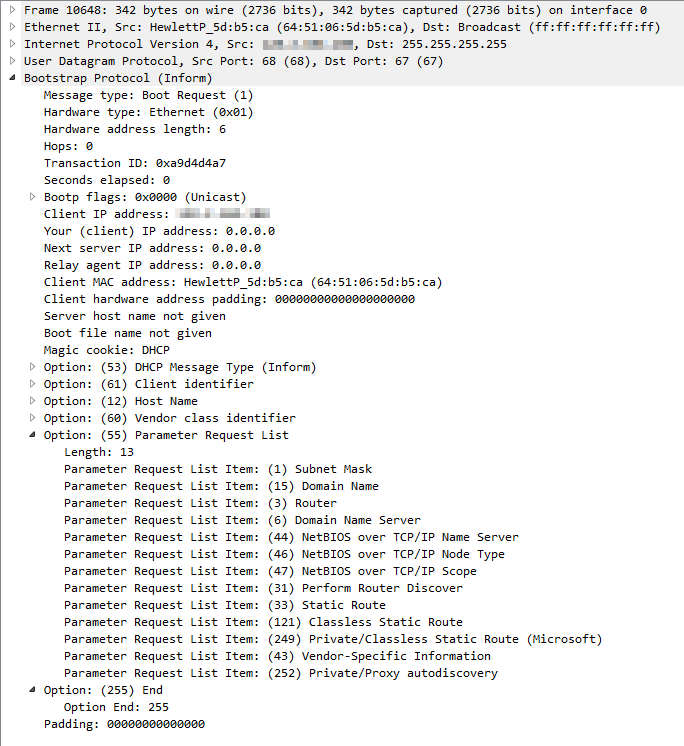Windows recieves wrong DNS server from DHCP after DHCPINFORM
Last week, I was surprisingly booked by a customer who observed a problem in his network. Unfortunately, colleagues worked on this network some day before (moving servers, routers etc. to a new pair of HP 7509 new core switches).
It was quickly clear, that some of the clients have received the wrong DNS servers from the DHCP server. The environment is a bit unusual. The customer is running two Active Directory domains (root and sub domain) in a single layer 2 broadcast domain. This nothing unusual, but he is also running two DHCP servers in the same layer 2 broadcast domain. To get this working, the customer uses exclusion ranges and reservations. This guarantees, that the client receives the correct DHCP information.
Observations
It was quicky clear, that some of the clients have received the wrong DNS servers from the DHCP server. That is the (defaced) output of a SUBDOM client with the correct IP settings.
IPv4 Address . . . . . . . . . . : 10.1.1.146(Preferred)
Subnet Mask . . . . . . . . . . . : 255.255.0.0
Default Gateway . . . . . . . . . : 10.1.1.1
DHCP Server . . . . . . . . . . . : 10.1.1.2
DNS Servers . . . . . . . . . . . : 10.1.1.2
10.10.1.2
And this is the output of the same client, after a reboot:
IPv4 Address . . . . . . . . . . : 10.1.1.146(Preferred)
Subnet Mask . . . . . . . . . . . : 255.255.0.0
Default Gateway . . . . . . . . . : 10.1.1.1
DHCP Server . . . . . . . . . . . : 10.1.1.2
DNS Servers . . . . . . . . . . . : 172.16.1.2
172.16.1.3
As you can see, the client got its DHCP information from the same DHCP server, but with the wrong DNS settings. The DNS servers are the servers from the ROOTDOM.
- only clients from SUBDOM were affected
- only Windows XP and Windows 7 clients were affected
- Windows 8.1 and Windows 10 clients were not affected
- Igel Thin Clients were not affected
- after an “ipconfig /renew”, the correct DNS servers were registered
- after an “ipconfig /release” and “ipconfig /renew”, the wrong DNS servers were registered
- the same happened after a reboot
- Wireshard packet trace showed, that the correct DNS information were included in the DHCPOFFER
The sum of observation told me, that this has nothing (or less) to do with the network changes. Interestingly, the correct DNS information were included in the DHCPOFFER and the behaviour was only observed on Windows XP and Windows 7. In addition, only clients of SUBDOM were affected.
The smoking gun
The packet trace with Wireshark showed, that the correct DNS information was included in the DHCPOFFER. But I also saw, that the client has sent a DHCPINFORM, which was answered by all available DHCP servers.

Patrick Terlisten/ vcloudnine.de/ Creative Commons CC0
DHCPINFORM is used by a client to discover more information, e.g. router, proxy, static routes… or DNS. The DHCPINFORM request was only sent after a reboot, or after a DHCPRELEASE and a subsequent DHCPDISCOVER. I saw that all available DHCP servers answered the DHCPINFORM request with a DHCPACK. This DHCPACK included the requested information, including DNS. I quickly developed the hypothesis, that the DHCPACK from the ROOTDOM DHCP servers was used by the client, to add the wrong DNS information to the configuration.
With this information, I quickly found a references (Meraki, Laurent Gaffié) to a registry key, that can be used to disable DHCPINFORM. This registry key is valid for Windows 2000, 2003, Windows XP, Windows Vista and Windows 7. Especially the blog post from Laurent Gaffié gave is interesting:
A vulnerability in Windows DHCP (http://www.ietf.org/rfc/rfc2131.txt) was found on Windows OS versions ranging from Windows 2000 through to Windows server 2003. This vulnerability allows an attacker to remotely overwrite DNS, Gateway, IP Addresses, routing, WINS server, WPAD, and server configuration with no user interaction.
It’s useful to disable DHCPINFORM, even if you don’t have a problem!
Disable DHCPINFORM
To disable DHCPINFORM, you must add a registry key for the network interface, that shouldn’t sent DHCPINFORM messages.
HKEY_LOCAL_MACHINE\SYSTEM\CurrentControlSet\Services\Tcpip\Parameters\Interfaces\{Interface GUID}
Value Type: DWORD
Value name: UseInform
DWORD Value: 0
Unfortunately the GUID of the interface differs between clients. I build this Visual Basic script (like Dr. Frankenstein: Different sources, plugged together, but it works) to add the registry key. You can run this script as part of a startup script with a Group Policy.
You should test this script very carefully! I provide this script “AS IS” with no warranties.
I don’t know why this has happened. I assume that the customer had this problem for some time. But due to some strange effects, he never noticed it. One hypothesis is, that the sequence of the DHCPACK messages after a DHCPINFORM has an influence. The DHCP server of ROOTDOM was moved to the new core switches, and maybe this changed the sequence of the answer packets. But it’s only a hypothesis, not a theory.
